

Welcome to the Kallidus blog. Curation as Digital Literacy Practice. Poster and evidence sheet.pdf. GDI - Conferences Detail - 11th European Trend Day. Teaching 21st Century. “Tip-of-the-Tongue Syndrome,” Transactive Memory, and How the Internet Is Making Us Smarter. The Disconnectionists. “Unplugging” from the Internet isn’t about restoring the self so much as it about stifling the desire for autonomy that technology can inspire Once upon a pre-digital era, there existed a golden age of personal authenticity, a time before social-media profiles when we were more true to ourselves, when the sense of who we are was held firmly together by geographic space, physical reality, the visceral actuality of flesh.
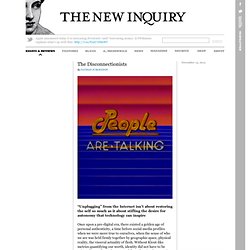
Without Klout-like metrics quantifying our worth, identity did not have to be oriented toward seeming successful or scheming for attention. TNI Vol. 22: Self-Help is out now. Subscribe now for $2 and get yours today. According to this popular fairytale, the Internet arrived and real conversation, interaction, identity slowly came to be displaced by the allure of the virtual — the simulated second life that uproots and disembodies the authentic self in favor of digital status-posturing, empty interaction, and addictive connection. The Social Media Guide to Growing Your Personal Learning Network. Personal learning networks are a great way for educators to get connected with learning opportunities, access professional development resources, and to build camaraderie with other education professionals.
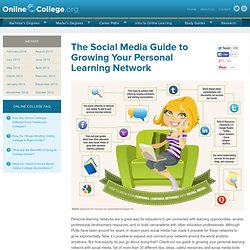
Although PLNs have been around for years, in recent years social media has made it possible for these networks to grow exponentially. Now, it’s possible to expand and connect your network around the world anytime, anywhere. But how exactly do you go about doing that? Check out our guide to growing your personal learning network with social media, full of more than 30 different tips, ideas, useful resources, and social media tools that can make it all possible. Tips & Ideas Get started developing your social media PLN with these tips and ideas for great ways to make use of social tools.
Three Significant Obstacles to Creating a Personal Learning Network. Last weekend, after enjoying Joe Morelock's keynote about the facing the challenges of rapid change in education, I shared my thoughts on personalized professional development with a group of about twenty eager educators.
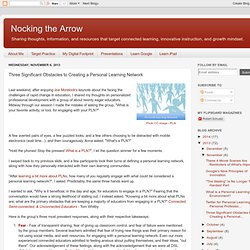
Midway through our session I made the mistake of asking the group, "What is your favorite activity, or tool, for engaging with your PLN? " A few averted pairs of eyes, a few puzzled looks, and a few others choosing to be distracted with mobile electronics (wait time...), and then courageously, Anna asked, "What's a PLN? " "Hold the phones! Stop the presses! 5 Reasons You Need A Digital Detox. The 10 Biggest Educational Trends (And What Teachers Think) We hear a lot about what things are popular in terms of technology, the cool new devices that are coming out, and trends that are happening with classroom technology integration.
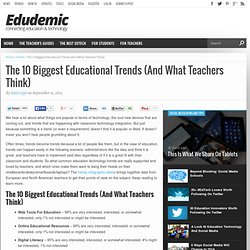
But just because something is a trend (or even a requirement) doesn’t that it is popular or liked. It doesn’t mean you won’t hear people grumbling about it. Often times, trends become trends because a lot of people like them, but in the case of education, trends can happen easily in the following scenario: administrators like the idea and think it is great, and teachers have to implement said idea regardless of if it is a great fit with their classroom and students.
So what common education technology trends are really supported and loved by teachers, and which ones make them want to bang their heads on their chalkboards/desks/smartboards/laptops? The handy infographic below brings together data from European and North American teachers to get their points of view on the subject.
Augmented Reality Brings New Dimensions to Learning. Editor's Note: Drew Minock, who co-wrote this piece, is an elementary teacher, co-founder of the popular education blog Two Guys and Some IPads, and is one of the voices on "The Two Guys Show" podcast.
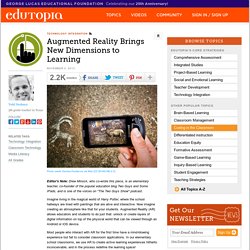
Imagine living in the magical world of Harry Potter, where the school hallways are lined with paintings that are alive and interactive. Now imagine creating an atmosphere like that for your students. Augmented Reality (AR) allows educators and students to do just that: unlock or create layers of digital information on top of the physical world that can be viewed through an Android or iOS device.
Most people who interact with AR for the first time have a mind-blowing experience but fail to consider classroom applications. 4 Reasons to Delete your Facebook Account. 79 "Student Literacy and Social Media" @TeachThought @tysonkimberly. Jeff sits down with Terry Hieck and Kimberly Tyson to talk about student literacy and how we can help our children navigate through the 21st century.

Podcast: Play in new window | Download | Embed Connected Learning: ‘PLAY’ from DML Research Hub on Vimeo. About Teach Thought TeachThought’s mantra is simple: learn better. Our mission is modest enough–to create a modern enlightenment that results in healthy communities and truly interdependent citizens. We believe that this can happen much more simply than it’d seem. Digital Citizenship: Resource Roundup. Big Thinkers on Education.